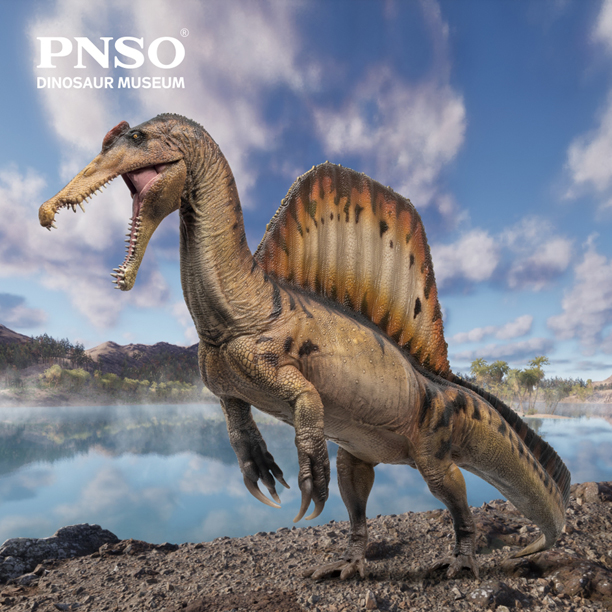Reviews, comments and feedback on television programmes featuring themes of interest to dinosaur fans and fossil collectors by Everything Dinosaur team members.
Spinosaurus the Fascinating River Dragon
Episode two of the eagerly anticipated BBC television series “Walking with Dinosaurs” features Spinosaurus aegyptiacus. The episode explores the story of Spinosaurus the river dragon. An adult Spinosaurus takes his offspring on a dangerous journey to reach rich feeding grounds. At the end of their trek an extraordinary feast awaits. However, the family has to travel through one of the most dangerous ecosystems to have ever existed. Welcome to North Africa in the Cretaceous.
Spinosaurus the River Dragon
Approximately a hundred million years ago, the area we now know as Morocco was part of an enormous river system. The environment consisted of extensive coastal plains nestled against a tropical sea. This region was home to huge variety of dinosaurs including giant theropods such as Spinosaurus and Carcharodontosaurus. The appearance of Spinosaurus has undergone several revisions. Sobek the Spinosaurus that features in this episode is similar to the PNSO Aymen the Spinosaurus figure. The PNSO Spinosaurus model (Aymen) was introduced last year (2024).
It depicts Spinosaurus as a biped and reflects the latest scientific research. The name Sobek is appropriate. Sobek was a crocodile-like God worshipped by the ancient Egyptians. The first Spinosaurus fossils to be discovered were found in Egypt.

Striding across the landscape but with water close by, the new for 2024 PNSO Aymen the Spinosaurus dinosaur model.
To view the range of PNSO models and figures in stock at Everything Dinosaur: PNSO Dinosaur Models.
The Changing Appearance of Spinosaurus
Isotope analysis of teeth indicates that Spinosaurus spent a lot of time in water. It has been depicted as a specialised piscivore. However, the anatomy and physical appearance of Spinosaurus has been revised.
Although almost all theropods are thought to have been bipedal, Spinosaurus has been regarded as a quadruped. In the 1970s illustrations featuring Spinosaurus depicted this carnivore as an animal that walked on all fours. This theory fell out of favour but was revised in 2014 following the publication of research that described new fossil material (Ibrahim et al). This study indicated that the hind limbs were much shorter than previously thought. The centre of mass was further forward rather than over the hips. This suggested that Spinosaurus was a quadruped.
Picture credit: Everything Dinosaur
Subsequent studies, not based on a composite skeleton made up of several specimens of different sizes, concluded that the centre of gravity was close to the hips. This indicates a bipedal stance.
The 2014 study (Ibrahim et al) suggesting Spinosaurus was an aquatic obligate quadruped: Spinosaurus – Four Legs are Better than Two.
The 2022 paper refuting the idea that Spinosaurus was almost entirely aquatic: Spinosaurus Not an Aquatic Dinosaur.
Mike from Everything Dinosaur commented:
“Spinosaurus remains one of the most enigmatic of all the theropods. Its appearance has been substantially revised over the last few years. It did not feature in the original BBC television series but was prominent in the BBC’s “Planet Dinosaur” series from 2011. The second episode of this new series highlights how our views regarding Spinosaurus have changed.”
Visit the user-friendly Everything Dinosaur website: Everything Dinosaur.

























